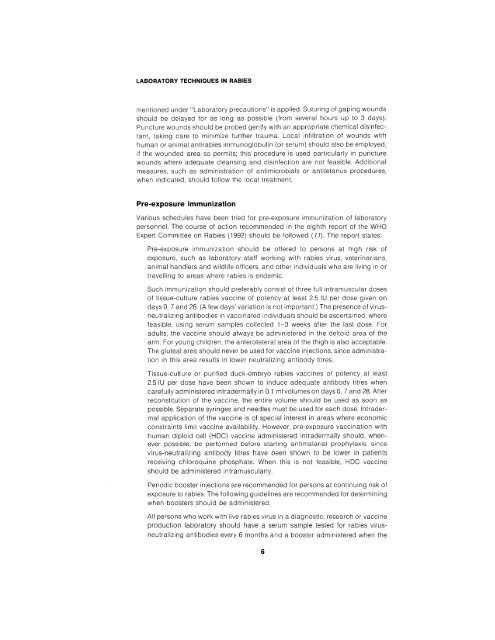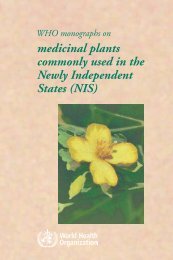in rabies - libdoc.who.int - World Health Organization
in rabies - libdoc.who.int - World Health Organization
in rabies - libdoc.who.int - World Health Organization
Create successful ePaper yourself
Turn your PDF publications into a flip-book with our unique Google optimized e-Paper software.
LABORATORY TECHNIQUES IN RABIES<br />
mentioned under "Laboratory precautions" is applied. Sutur<strong>in</strong>g of gap<strong>in</strong>g wounds<br />
should be delayed for as long as possible (from several hours up to 3 days).<br />
Puncture wounds should be probed gently with an appropriate chemical dis<strong>in</strong>fectant,<br />
tak<strong>in</strong>g care to m<strong>in</strong>imize further trauma, Local <strong>in</strong>filtration of wounds with<br />
human or animal ant<strong>rabies</strong> irnniunoglobul<strong>in</strong> (or serum) should also be employed.<br />
if the wounded area so permits; this procedure is used particularly <strong>in</strong> puncture<br />
wounds where adequate cleans<strong>in</strong>g and dis<strong>in</strong>fection are not feasible. Additional<br />
measures, such as adm<strong>in</strong>istration of antimicrobials or antitetanus procedures.<br />
when <strong>in</strong>dicated, should follow the local treatment.<br />
Pre-exposure immunization<br />
Various schedules have been tried for pie-exposure immunization of laboratory<br />
personnel. The course of action recommended <strong>in</strong> the eighth report of the WHO<br />
Expert Committee on Rabies (1992) should be followed (11). The report states:<br />
Pre-exposure immunization should be offered to persons at high risk of<br />
exposure, such as laboratory staff work<strong>in</strong>g w~th <strong>rabies</strong> virus veter<strong>in</strong>arans<br />
animal handlers and wildlife officers, and other <strong>in</strong>dividuals <strong>who</strong> are liv<strong>in</strong>g <strong>in</strong> or<br />
travell<strong>in</strong>g to areas where <strong>rabies</strong> is endemic<br />
Such immunization should preferably consist of three full <strong>in</strong>tramuscular doses<br />
of tissue-culture <strong>rabies</strong> vacc<strong>in</strong>e of potency at least 25 IU per dose given on<br />
days 0 7 and 28 (Afew days variation is not important ) The presence of virusneutraliz<strong>in</strong>g<br />
antibodies <strong>in</strong> vacc<strong>in</strong>ated <strong>in</strong>dividuals should be ascerta<strong>in</strong>ed where<br />
feasible us<strong>in</strong>g serum samples collected 1-3 weeks after the last dose For<br />
adults the vacc<strong>in</strong>e should always be adm<strong>in</strong>istered <strong>in</strong> the deltoid area of the<br />
arm For young children the anterolateral area of the thigh is also acceptable<br />
The guteal area sliould never be used for vacc<strong>in</strong>e <strong>in</strong>jections s<strong>in</strong>ce adm<strong>in</strong>istrat~on<br />
<strong>in</strong> this area results <strong>in</strong> lower neutraliz<strong>in</strong>g antibody titres<br />
Tissue-culture or purified duck-embryo <strong>rabies</strong> vacc<strong>in</strong>es of potency at least<br />
2.5 IU per dose have been shown to <strong>in</strong>duce adequate antibody titres when<br />
carefully adm<strong>in</strong>istered <strong>in</strong>tradermally <strong>in</strong> 0.1 ml volumes on days 0, 7 and 28. After<br />
reconstitution of the vacc<strong>in</strong>e, the entire volume should be used as soon as<br />
possible. Separate syr<strong>in</strong>ges and needles must be used for each dose. lntradermal<br />
application of the vacc<strong>in</strong>e is of special <strong>in</strong>terest <strong>in</strong> areas where economic<br />
constra<strong>in</strong>ts limit vacc<strong>in</strong>e availability. However, pre-exposure vacc<strong>in</strong>ation with<br />
human diploid cell (HDC) vacc<strong>in</strong>e adm<strong>in</strong>istered <strong>in</strong>tradermally should, whenever<br />
possible, be performed before start<strong>in</strong>g antimalarial prophylaxis, s<strong>in</strong>ce<br />
virus-neutraliz<strong>in</strong>g antibody hires have been shown to be lower <strong>in</strong> patients<br />
receiv<strong>in</strong>g chloroqu<strong>in</strong>e phosphate. When this is not feasible, HDC vacc<strong>in</strong>e<br />
should be adm<strong>in</strong>istered <strong>in</strong>tramuscularly.<br />
Periodic booster <strong>in</strong>jections are recommended for persons at cont<strong>in</strong>u<strong>in</strong>g risk of<br />
exposure to <strong>rabies</strong>. The follow<strong>in</strong>g guidel<strong>in</strong>es are recommended for determ<strong>in</strong><strong>in</strong>g<br />
when boosters should be adm<strong>in</strong>istered:<br />
All persons <strong>who</strong> work with live <strong>rabies</strong> virus <strong>in</strong> a diagnostic, research or vacc<strong>in</strong>e<br />
production laboratory should have a serum sample tested for <strong>rabies</strong> virusneutraliz<strong>in</strong>g<br />
antibodies every 6 months and a booster adm<strong>in</strong>istered when the
















